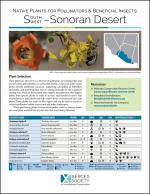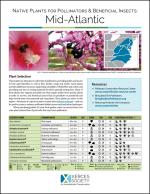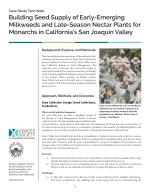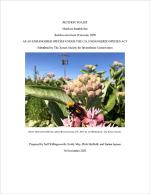As a science-based organization, the Xerces Society produces dozens of publications annually, all of which employ the best available research to guide effective conservation efforts. Our publications range from guidelines for land managers, to brochures offering overviews of key concepts related to invertebrate conservation, from books about supporting pollinators in farmland, to region-specific plant lists. We hope that whatever you are seeking—whether it's guidance on making a home or community garden pollinator-friendly, advice on developing a local pesticide reduction strategy, or detailed information on restoring habitat—you will find it here!
Find Publications
Use the search functions to sort by publication type (books, guidelines, fact sheets, etc.), location, and/or subject (agriculture, gardens, pollinators, pesticides, etc.).
This regional plant list highlights native plants that are highly attractive as food sources for adult pollinators; support caterpillars of butterflies and moths; serve as nesting material or sites for certain bees; provide pollen for bees with specialized pollen needs; and feed beneficial predators and parasitoids that contribute to pest control. For those looking for just a few key plants, our staff have flagged their favorites.
This regional plant list highlights native plants that are highly attractive as food sources for adult pollinators; support caterpillars of butterflies and moths; serve as nesting material or sites for certain bees; provide pollen for bees with specialized pollen needs; and feed beneficial predators and parasitoids that contribute to pest control. For those looking for just a few key plants, our staff have flagged their favorites.
This regional plant list highlights native plants that are highly attractive as food sources for adult pollinators; support caterpillars of butterflies and moths; serve as nesting material or sites for certain bees; provide pollen for bees with specialized pollen needs; and feed beneficial predators and parasitoids that contribute to pest control. For those looking for just a few key plants, our staff have flagged their favorites.
This regional plant list highlights native plants that are highly attractive as food sources for adult pollinators; support caterpillars of butterflies and moths; serve as nesting material or sites for certain bees; provide pollen for bees with specialized pollen needs; and feed beneficial predators and parasitoids that contribute to pest control. For those looking for just a few key plants, our staff have flagged their favorites.
Identify native plants that attract native pollinators and beneficial insects in the Southern Plains region.
Identify native plants that attract native pollinators and beneficial insects in the Southeast region.
Identify native plants that attract native pollinators and beneficial insects in the Northeast region.
Identify native plants that attract native pollinators and beneficial insects in the Midwest region.
Identify native plants that attract native pollinators and beneficial insects in the Mid-Atlantic region.
Identify native plants that attract native pollinators and beneficial insects in Florida.













